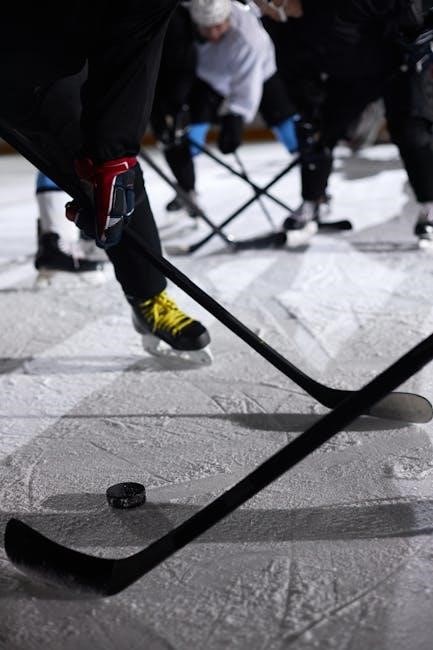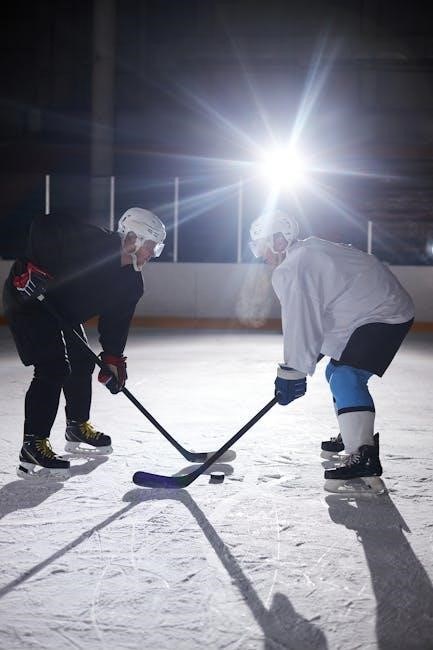
hockey skate size guide
Proper hockey skate sizing is essential for comfort, performance, and protection. This guide helps you understand how to choose the right size, ensuring a perfect fit for optimal skating experience.
Overview of Hockey Skate Fit Importance
A proper hockey skate fit is crucial for performance, comfort, and protection. Ill-fitting skates can lead to discomfort, reduced mobility, and increased risk of injury. A snug yet comfortable fit ensures optimal support and responsiveness, allowing players to skate efficiently and maintain control. Poorly fitting skates can hinder performance and cause fatigue. Understanding the importance of skate fit helps players achieve better overall skating experiences and prevents potential issues during games or practices.
Key Considerations for Choosing the Right Skate Size
Choosing the right skate size involves measuring foot length, considering shoe size differences, and ensuring proper fit. Seniors typically size down 1.5 from their shoe size, while juniors and youth size down 1;0. Foot length, width, and personal comfort are critical. Conversion charts and manufacturer guides can help, but trying skates on is essential. Proper fit ensures performance, comfort, and injury prevention. Always consider brand-specific sizing variations and personal skating style when selecting the ideal skate size.

Understanding Skate Width and Fit
Skate width and fit significantly impact performance. Traditional, contoured, and tapered options cater to different foot shapes and skating styles, ensuring comfort and stability on the ice.
Traditional Skate Width (Width Ratio < 2.5)
Traditional skate width offers a wider fit with a ratio below 2.5. This style suits players with broader feet or those preferring a roomier toe box for comfort. It allows for better stability and maneuverability, making it ideal for defensemen or players needing durability. The wider design helps distribute pressure evenly, reducing discomfort during long games or intense play.
Contoured Skate Width (Width Ratio 2;5 – 3.0)
Contoured skate width, with a ratio of 2.5–3.0, offers a snug, anatomical fit, hugging the foot for better support and flexibility. This design is ideal for players with average to narrower feet, providing a balance between comfort and performance. The contoured shape enhances agility and control, making it a popular choice for skaters seeking a responsive feel. It’s particularly beneficial for forwards or players requiring quick, precise movements on the ice.
Tapered Skate Width (Width Ratio > 3.0)
Tapered skate width, with a ratio exceeding 3.0, is designed for players seeking maximum support and stability. This stiffer, narrower fit is ideal for advanced or professional skaters, offering enhanced performance and responsiveness. Tapered skates are typically used by elite players who prioritize power and precision in their skating, making them a top choice for those requiring high-level support and control during intense gameplay.

How Skate Size Relates to Shoe Size
Senior hockey skates fit 1.5 sizes down from shoe size, while junior and youth skates fit 1.0 size down, ensuring proper fit for comfort and performance.
Senior Hockey Skates Sizing (1.5 Sizes Down from Shoe Size)
Senior hockey skates typically fit 1.5 sizes smaller than your standard shoe size. This allows for a snug, responsive fit, enhancing performance and comfort. Proper sizing ensures your toes lightly touch the cap without constriction. Measure carefully, as sizing can vary slightly between brands. Trying skates on with thin socks and ensuring proper heel lock is recommended for optimal fit and to prevent discomfort during play.
Junior and Youth Hockey Skates Sizing (1.0 Size Down from Shoe Size)
Junior and youth hockey skates are sized 1.0 size smaller than standard shoe sizes to ensure a snug, supportive fit. This sizing accommodates growing feet while maintaining performance. Proper fit means toes should lightly touch the skate’s toe cap, with no excessive movement. Heel fit is crucial to prevent slipping and improve control. When trying on skates, wear thin socks and stand upright to ensure accuracy. Correct sizing supports skill development and comfort for young players.
Skate Size Conversion Charts
Conversion charts help translate shoe sizes to skate sizes, ensuring accurate fitting. EU to US size comparisons are commonly used for precise measurements and optimal skate performance.
Using a Conversion Chart for Accurate Sizing
A conversion chart is a valuable tool for ensuring your hockey skates fit perfectly. By aligning your shoe size with the corresponding skate size, you can avoid sizing mismatches. Senior skates typically fit 1.5 sizes down from shoe size, while junior and youth skates fit 1.0 size down. Charts may vary by brand, so always refer to the specific manufacturer’s guide. Measure foot length and compare it to the chart for precise sizing. Proper fit ensures comfort, performance, and protection on the ice.
EU to US Size Conversion for Hockey Skates
Converting EU to US sizes for hockey skates is crucial for a precise fit. EU sizes are typically 1.5 sizes larger than US sizes. For example, a US size 10 corresponds to an EU size 42.5. Use conversion charts provided by manufacturers to ensure accuracy, as sizing can vary slightly between brands. Proper conversion guarantees optimal comfort and performance, preventing issues like tightness or excessive room in the boot. Always check the specific brand’s conversion guide for exact measurements.
Measuring Your Foot for Skate Sizing
Measure your foot length from heel to toe and width at the ball. Compare these to the manufacturer’s size chart for accurate hockey skate sizing.
How to Measure Foot Length for Skate Fit
Stand upright and place your foot against a wall, keeping your weight evenly distributed. Use a ruler to measure the distance from the wall to the tip of your longest toe. This gives your foot length. Ensure the foot is flat and not bent, as this can affect accuracy. Record the measurement and compare it to the manufacturer’s sizing chart to determine the best skate fit for optimal performance and comfort.
Using Skate Sizing Guides for Proper Measurement
Consulting a skate sizing guide ensures accurate measurement and fit. Compare your foot length to the manufacturer’s chart, as sizes vary between brands. Senior skates typically fit 1.5 sizes smaller than shoe size, while junior and youth skates fit 1.0 size down. Use a conversion chart for EU to US size accuracy. Place your foot flat against a wall, measure to the longest toe, and match this to the guide for optimal fit and performance.
Skate Fit and Comfort
A proper fit ensures comfort and performance. Try skates on with thin socks, as they should feel snug but not tight. Toes should barely touch the cap, with minimal heel movement for optimal support and stability during skating.
Trying Skates On: What to Look For
When trying on hockey skates, ensure a snug fit with thin socks. Toes should lightly touch the toe cap, and heels should feel secure without slipping. Walk or skate briefly to gauge comfort and support. Proper fit allows for slight movement but avoids pressure points. Skates may feel stiff initially but should mold to your feet over time. Pay attention to the overall feel and mobility to ensure optimal performance and comfort during play.
Importance of Toe Room and Heel Fit
Proper toe room and heel fit are crucial for comfort and performance in hockey skates. The toes should have enough space to move slightly, preventing pain and numbness during play. A snug heel fit ensures stability, reducing the risk of blisters and improving skating efficiency. If the heel slips, it can hinder performance and cause discomfort. Ensure the skates feel comfortable but firm, as they will mold to your feet over time. Trying them on with thin socks and skating briefly can help determine the proper fit.
Skate Lace Length and Sizing
Choosing the right lace length ensures optimal performance and comfort. Laces should be long enough to secure the foot snugly without being overly bulky or restrictive.
Choosing the Right Lace Length for Your Skate Size
Selecting the appropriate lace length is crucial for both comfort and performance. Longer laces provide a secure fit, while shorter ones may restrict movement. Use a sizing chart to match your skate size with the ideal lace length, ensuring enough length to pass through all eyelets without excess. Properly laced skates enhance stability and control, allowing for better skating efficiency and maneuverability on the ice.
Lace Length Sizing Chart for Optimal Performance
A lace length sizing chart simplifies finding the ideal fit for your skates. By aligning your skate size with the recommended lace length, you ensure optimal performance. Longer laces provide a snug, secure fit, while shorter ones may restrict movement. Proper lacing enhances stability and control, crucial for skating efficiency and maneuverability. Refer to the chart to match your skate size with the perfect lace length, ensuring a comfortable and responsive skating experience.

Specialized Skate Sizing Needs
Skate sizing varies by gender, skill level, and skate type, requiring tailored fits. Senior skates fit 1.5 sizes smaller than shoe size, while juniors fit 1.0 size down, ensuring optimal performance and comfort.
Gender-Specific Sizing Differences
Hockey skate sizing varies between genders due to differences in foot shape and skating style. Men’s skates often have a wider, more robust fit, while women’s skates are generally narrower and more contoured for a snug heel and toe fit. Senior men’s skates typically fit 1.5 sizes down from shoe size, while women’s skates may fit closer to shoe size or slightly smaller. Junior and youth skates follow similar patterns but are scaled down for smaller feet. Always check manufacturer-specific sizing guides for gender-specific recommendations to ensure the best fit and performance.
Skate Sizing for Different Skill Levels
Skate sizing needs vary by skill level, with higher levels requiring tighter fits for precision and speed. Elite players often prefer a snug fit for better control, while intermediate skaters may prioritize comfort. Beginners benefit from slightly roomier skates for ease of movement. Proper sizing ensures optimal performance, regardless of skill level. Always measure feet and try skates on to confirm fit, as sizing can vary between brands and models. Proper fit enhances skating efficiency and overall performance.

FAQs About Hockey Skate Sizing
Frequently asked questions about hockey skate sizing address fit, comfort, and performance. Common inquiries include how to determine the right size, differences between brands, and proper lacing techniques. Many skaters also ask about the importance of sock thickness and how it affects sizing. Additionally, there are questions about the ideal amount of toe room and heel snugness for optimal skating efficiency. These FAQs provide essential insights for both new and experienced skaters.
Common Questions About Skate Fit and Sizing
Skaters often inquire about the ideal fit, asking how tight or loose skates should feel. Many wonder about the correct amount of toe room and heel snugness. Others seek advice on choosing between senior, junior, or youth sizes. Questions about sizing differences between brands are frequent, as are inquiries regarding lace length and its impact on performance. Additionally, skaters ask about the importance of sock thickness and how it affects sizing. These questions highlight the complexity of achieving a perfect fit for optimal skating performance and comfort.
Addressing Sizing Confusion Between Brands
Different brands often have varying sizing standards, leading to confusion. Bauer, CCM, and Graf each have unique fits. Bauer skates tend to fit narrower, while CCM offers a wider toe box. Graf skates are known for their stiffness and precise fit. To avoid confusion, consult each brand’s specific sizing chart and consider trying on skates if possible. Understanding these differences ensures a better fit and enhances skating performance. Always check brand-specific guidelines for accurate sizing.